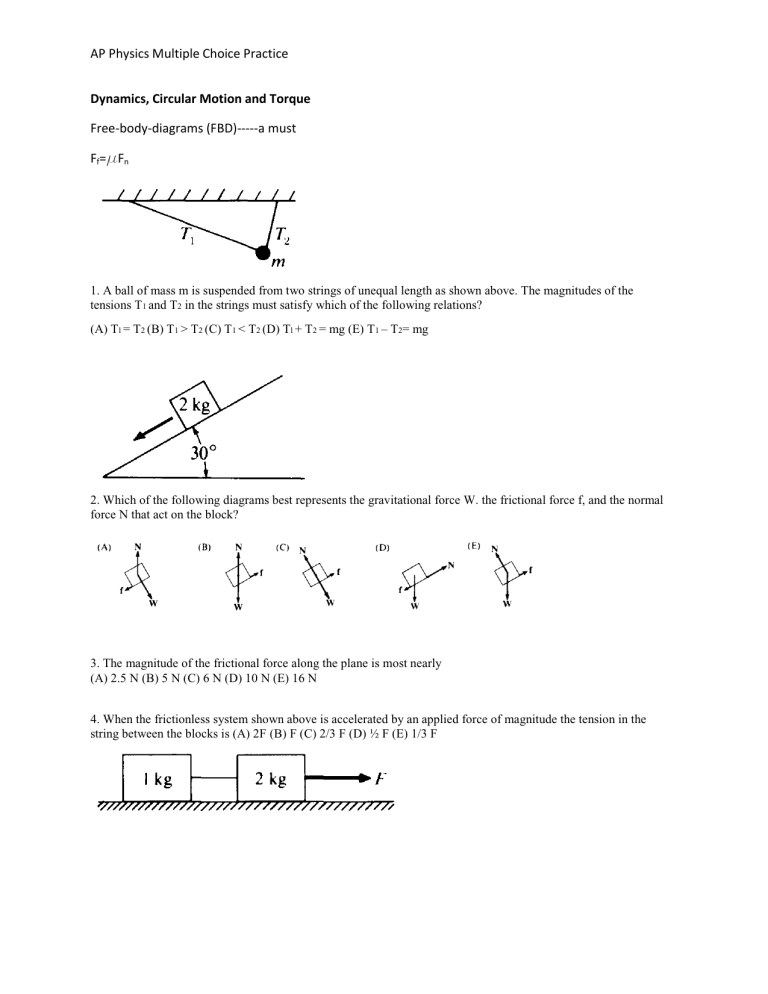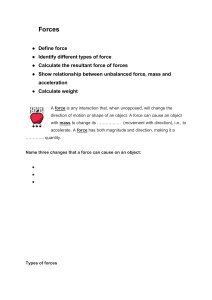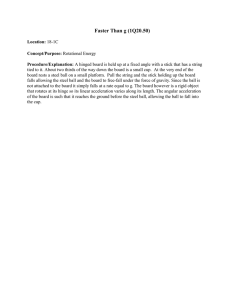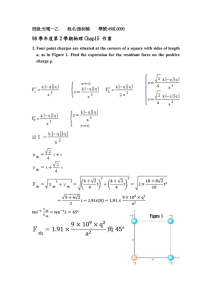
AP Physics Multiple Choice Practice Dynamics, Circular Motion and Torque Free-body-diagrams (FBD)-----a must Ff=μFn 1. A ball of mass m is suspended from two strings of unequal length as shown above. The magnitudes of the tensions T1 and T2 in the strings must satisfy which of the following relations? (A) Tl = T2 (B) T1 > T2 (C) T1 < T2 (D) Tl + T2 = mg (E) T1 – T2= mg 2. Which of the following diagrams best represents the gravitational force W. the frictional force f, and the normal force N that act on the block? 3. The magnitude of the frictional force along the plane is most nearly (A) 2.5 N (B) 5 N (C) 6 N (D) 10 N (E) 16 N 4. When the frictionless system shown above is accelerated by an applied force of magnitude the tension in the string between the blocks is (A) 2F (B) F (C) 2/3 F (D) ½ F (E) 1/3 F AP Physics Multiple Choice Practice 5. A ball falls straight down through the air under the influence of gravity. There is a retarding force F on the ball with magnitude given by F = bv, where v is the speed of the ball and b is a positive constant. The magnitude of the acceleration, a of the ball at any time is equal to which of the following? (A) g – b (B) g – bv/m (C) g + bv/m (D) g/b (E) bv/m 6. A push broom of mass m is pushed across a rough horizontal floor by a force of magnitude T directed at angle θ as shown above. The coefficient of friction between the broom and the floor is μ. The frictional force on the broom has magnitude (A) μ(mg + Tsinθ) (B) μ(mg – Tsinθ) (C) μ(mg + Tcosθ) (D) μ(mg – Tcosθ) (E) μmg A plane 5 meters in length is inclined at an angle of 37°, as shown above. A block of weight 20 newtons is placed at the top of the plane and allowed to slide down. 12. The mass of the block is most nearly (A) 1.0 kg (B) 1.2 kg (C) 1.6 kg (D) 2.0 kg (E) 2.5 kg 13. The magnitude of the normal force exerted on the block by the plane is most nearly (A) 10 N (B) 12 N (C) 16 N (D) 20 N (E) 33 N AP Physics Multiple Choice Practice 24. A 100-newton weight is suspended by two cords as shown above. The tension in the slanted cord is (A) 50 N (B) 100 N (C) 150 N (D) 200 N (E) 250 N 26. A ball initially moves horizontally with velocity vi, as shown above. It is then struck by a stick. After leaving the stick, the ball moves vertically with a velocity vf, which is smaller in magnitude than vi. Which of the following vectors best represents the direction of the average force that the stick exerts on the ball? Questions 36 – 38 A small box is on a ramp tilted at an angle θ above the horizontal. The box may be subject to the following forces: frictional (f ) ,gravitational (mg), pulling or pushing (FP) and normal (I). In the following free-body diagrams for the box, the lengths of the vectors are proportional to the magnitudes of the forces. 36. Which figure best represents the free-body diagram for the box if it is accelerating up the ramp? (A) Figure A (B) Figure B (C) Figure C (D) Figure D (E) Figure E 37. Which figure best represents the free-body diagram for the box if it is at rest on the ramp? (A) Figure A (B) Figure B (C) Figure C (D) Figure D (E) Figure E 38. Which figure best represents the free-body diagram for the box if it is sliding down the ramp at constant speed? (A) Figure A (B) Figure B (C) Figure C (D) Figure D (E) Figure E AP Physics Multiple Choice Practice 40. A horizontal force F pushes a block of mass m against a vertical wall. The coefficient of friction between the block and the wall is μ. What value of F is necessary to keep the block from slipping down the wall? (A) mg (B) μ mg (C) mg/μ (D) mg(1 - μ) (E) mg(1 + μ) 51. A string with masses of 1.5 kg and 3.0 kg on its ends is hung over a frictionless, massless pulley as shown to the right. What is the approximate magnitude of the acceleration of the masses? (A) 1.5 m/s2 (B) 3.0 m/s2 (C) 3.3 m/s2 (D) 6.7 m/s2 (E) 10 m/s2 Questions 72 – 74 A 2 kg mass and a 4 kg mass on a horizontal frictionless surface are connected by a massless string A. They are pulled horizontally across the surface by a second string B with a constant acceleration of 12 m/s 2. 72. What is the magnitude of the force of string B on the 2 kg mass? (A) 72 N (B) 48 N (C) 24 N (D) 6 N (E) 3 N 73. What is the magnitude of the force of string A on the 4 kg mass? (A) 72 N (B) 48 N (C) 24 N (D) 6 N (E) 3 N 74. What is the magnitude of the net force on the 2 kg mass? (A) 72 N (B) 48 N (C) 24 N (D) 6 N (E) 3 N 100. Two masses 5.0 and 7.0 kg are originally at rest on a frictionless surface. The masses are connected by a light cord. A second cord is attached to the 7.0 kg mass and pulled with a horizontal force of 30 N. What is the tension in the cord that connects the two masses? (A) 5 N (B) 7 N (C) 12.5 N (D) 17.5 N (E) 30 N AP Physics Multiple Choice Practice F-t graphs F=ma N=kg*m/s2 34. A block of mass 3 kg, initially at rest, is pulled along a frictionless, horizontal surface with a force shown as a function of time t by the graph above. The acceleration of the block at t = 2 s is (A) 3/4 m/s2 (B) 4/3 m/s2 (C) 2 m/s2 (D) 8 m/s2 (E) 12 m/s2 69. The graph at left shows the relationship between the mass of a number of rubber stoppers and their resulting weight on some far-off planet. The slope of the graph is a representation of the: (A) mass of a stopper (B) density of a stopper (C) volume of a stopper (D) acceleration due to gravity (E) number of stoppers for each unit of weight AP Physics Multiple Choice Practice Circular Motion Fc=mv2/r v=d/t=circ/period circumference=2rp 1. When a person stands on a rotating merry-go-round, the frictional force exerted on the person by the merry-go-round is (A) greater in magnitude than the frictional force exerted on the person by the merry-go-round (B) opposite in direction to the frictional force exerted on the merry-go-round by the person (C) directed away from the center of the merry-go-round (D) zero if the rate of rotation is constant (E) independent of the person's mass 2. A ball attached to a string is whirled around in a horizontal circle having a radius r. If the radius of the circle is changed to 4r and the same centripetal force is applied by the string, the new speed of the ball is which of the following? ( A) One-quarter the original speed (B) One-half the original speed (C) The same as the original speed (D) Twice the original speed (E) Four times the original speed 3. A racing car is moving around the circular track of radius 300 meters shown above. At the instant when the car's velocity is directed due east, its acceleration is directed due south and has a magnitude of 3 meters per second squared. When viewed from above, the car is moving (A) clockwise at 30 m/s ( B) clockwise at 10 m/s (C) counterclockwise at 30 m/s (D) counterclockwise at 10 m/s (E) with constant velocity 4. The horizontal turntable shown above rotates at a constant rate. As viewed from above, a coin on the turntable moves counterclockwise in a circle as shown. Which of the following vectors best represents the direction of the frictional force exerted on the coin by the turntable when the coin is in the position shown? A B C D E AP Physics Multiple Choice Practice 5. In which of the following situations would an object be accelerated? I. It moves in a straight line at constant speed. II. It moves with uniform circular motion. III. It travels as a projectile in a gravitational field with negligible air resistance. (A) I only (B) III only (C) I and II only (D) II and III only (E) I, II, and III. 8. A child has a toy tied to the end of a string and whirls the toy at constant speed in a horizontal circular path of radius R. The toy completes each revolution of its motion in a time period T. What is the magnitude of the acceleration of the toy? (A) Zero (B) 4 π2 R2/ T2 (C) πR/T 2 (D) g (E) 2πg 9. A compressed spring mounted on a disk can project a small ball. When the disk is not rotating, as shown in the top view above, the ball moves radially outward. The disk then rotates in a counterclockwise direction as seen from above, and the ball is projected outward at the instant the disk is in the position shown above. Which of the following best shows the subsequent path of the ball relative to the ground? 12. A ball of mass m is attached to the end of a string of length Q as shown above. The ball is released from rest from position P. where the string is horizontal. It swings through position Q. where the string is vertical, and then to position R. where the string is again horizontal. What are the directions of the acceleration vectors of the ball at positions Q and R? (A) (B) (C) (D) (E) Position Q Position R Downward Downward Upward Upward To the right Downward To the right Downward To the left To the left AP Physics Multiple Choice Practice 21. Assume the roller coaster cart rolls frictionlessly along the curved track from point A to point C under the influence of gravity. What would be the direction of the cart's acceleration at point B? (A) upward (B) downward (C) forward (D) backward (E) no acceleration Questions 22 – 23 The diagram below is a snapshot of three cars all moving counterclockwise during a one lap race on an elliptical track. 22. Which car has had the lowest average speed during the race so far? (A) car A (B) car B (C) car C (D) all three cars have had the same average speed (E) cannot be determined with information provided 23. Which car at the moment of the snapshot MUST have a net force acting on it? (A) car A (B) car B (C) car C (D) all three cars have net forces acting on them (E) cannot be determined with information provided 24. A centripetal force of 5.0 newtons is applied to a rubber stopper moving at a constant speed in a horizontal circle. If the same force is applied, but the radius is made smaller, what happens to the speed, v, and the frequency, f, of the stopper? (A) v increases & f increases (B) v decreases & f decreases (C) v increases & f decreases (D) v decreases & f increases (E) neither changes AP Physics Multiple Choice Practice Torque (rotational motion, rotational equilibrium) ΣT=F*r=0 =ΣFx=ΣFy=0 1. A uniform meterstick of mass 0.20 kg is pivoted at the 40 cm mark. Where should one hang a mass of 0.50 kg to balance the stick? (A) 16 cm (B) 36 cm (C) 44 cm (D) 46 cm (E) 54 cm 5. A uniform meter stick has a 45.0 g mass placed at the 20 cm mark as shown in the figure. If a pivot is placed at the 42.5 cm mark and the meter stick remains horizontal in static equilibrium, what is the mass of the meter stick? (A) 18.0 g (B) 45.0 g (C) 72.0 g (D) 120.0 g (E) 135.0 g 9. Two objects, of masses 6 and 8 kilograms, arehung from the ends of a stick that is 70 cm long and has marks every 10 cm, as shown. If the mass of the stick is negligible, at which of the points indicated should a cord be attached if the stick is to remain horizontal when suspended from the cord? (A) A (B) B (C) C (D) D (E) E 10. A wheel of radius R and negligible mass is mounted on a horizontal frictionless axle so that the wheel is in a vertical plane. Three small objects having masses m, M, and 2M, respectively, are mounted on the rim of the wheel, as shown. If the system is in static equilibrium, what is the value of m in terms of M? (A) M/2 (B) M (C) 3M/2 (D) 2M (E) 5M/2




